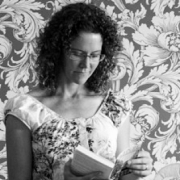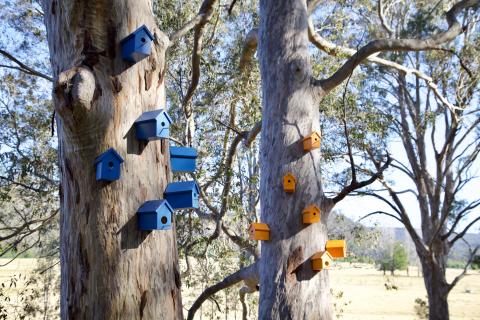MICRO: little things mean a lot
As soon as you drive down the long dirt road to the gate, the atmosphere at Bundanon Trust’s 2018 Siteworks becomes anticipatory. Rocking from side to side across the wombat-infested grassy paddock in my tiny Fiat 500 brings me to the main entrance. Overnight camping tents festoon the hillside and behind the main historic homestead are multiple food trucks and a bar. The audience will soon discover new artworks, performances and video installations. People smile broadly. Kids run and squeal, finding it hard to decide whether to chase the wombats and kangaroos or play hide and seek in the hill’s trees behind. There is the ambient sound of art—theatrical voices, deep recorded sound, the whir of screen generators and the odd burst of enthusiastic applause. The mood is infectious.
This year’s Siteworks is titled MICRO: little things mean a lot. It comprises artworks that respond to the miniature or the microscopic. For instance, there is an artwork focusing on the decomposition at the close of life, and microscopy images of Maratus spiders in their lively mating dance. The remit of the pastoral Bundanon Trust property includes the care, restoration and re-imagining of how humans can relate to their natural/unnatural ecologies, especially the really small scale. The miniature has been written about by Susan Stewart in her book On Longing and by Gaston Bachelard in his book in The Poetics of Space. Both philosophers refer to the sublime sense of feeling safe with the small. This is an aesthetic of curiosity and intrigue—and of the cuteness of the small. The minute is confined, observed and analysable. This also brings to mind the aesthetic of ecological art, in terms of what criteria makes a good eco artwork? Must it have an immersive, enclosing, scalable sensation? Must it have an environmental message? Must it look and feel green? Can that greenness ever be apolitical?
I approach the artworks, pre-aware of an experiential Australia-adapted work Bushland by UK artists French and Mottershead, part of their Afterlife series, which requires headphones, iPhone and yoga mat. So, I wander down the rocky northern incline towards the lake and wind around its girth towards the Shoalhaven River. There’s a sunny spot amongst some head-high saplings. The drought-ridden cracked earth is peppered with ants, as I settle down on the mat. The view is of the empty blue sky and canopies of casuarinas and gums. I hear tiny birds hop from branch to branch and, when the wind picks up, the identifiably quiet roar of casuarina needles. I press ‘play’ and the second person narrative begins.
This is a story of detailed decomposition of a body in the bush—it’s not ad hoc but full of anthropological, forensic and scientific precision. The body stiffens in the first few days but as time wears on, the jaw slackens and drops, the shoulders and hands settle. Flies start to arrive on the body in greater numbers as they search for a moist warm place to lay its maggoty eggs. The mouth. As I am told this part of the story, a fly alights on my hand. I flick my hand defensively: I’m not dead yet. Eyes bulge, intestines swell and blacken, stomach pushes out the skin. Maggot eggs spawn and start to feed. Magpies and crows fly low to pick at the offerings. Ants relentlessly march. Bugs and worms create a patchwork of travel. Once the flesh has depleted, small foxes stop by to eat out the bone marrow. Eventually, bones that have been left for many years harden and become fossilized.
The effect of this narrative, with the sounds of the environs permeating the earphones, is that the sensory experience is full of life. So many species benefit from our human death. The flannel flowers are abundant where the body once lay. This is the test: can an artwork create change? So many insects, birds and small animals are fed by this process of human decomposition. After the decomposition experience, and as someone who has always thought cremation would be the best choice after death, I reconsider. I am now not sure what my decision will be, post-life. So this work fulfils an ecological art aesthetic because it looks and feels green and it has an overarching political message—humans are only as relevant as their ecologies.
Another work that suggests an ecological aesthetic is Maria Fernanda Cardoso’s spider installation, Dancing with Spiders: On the Origins of Art III-VIII (2017), which comprises three free-standing screens and three circular viewing stages and is located in the empty dry bed of the lake (which was full of water last year). The audience is tentative and unsure as they first approach Cardoso’s work, just as dusk falls. Children scuttle in the semi-dark, in tandem with the spiders, smaller than a flea in life, but nearly five metres high in her artwork. Cardoso is mistress of the small scale writ large. Her work in the Biennale of Sydney (The Museum of Copulatory Plants, 2012) and her Cardoso Flea Circus at the Opera House in (2002) were microscopic studies into the complex lives of insects. Fleas and spiders can be mastered, just like lions in the lion cage at the circus, or the cutting horses at the rodeo.
For Dancing with Spiders Cardoso trained her tiny male spiders to poise on a galvanised nail. With camera at the ready and a female spider behind the camera, for the males to perform for, she took videos of their mating dances. These colourful and charismatic spiders shake and wave their arms. The reverberations these spiders make were recorded and fed into the three stages so that the rumble of sound waves can be felt under our feet. Cardoso is a conventional observational nature artist but with a slightly ghoulish, pantomime element. This is the fascination of nature, presented as entertainment. Roll up, roll up. A small child near the screen calls to its mother, ‘something bit me’ and his little friends roar with laughter and reply ‘it was the spider, it was the spider’. This is the sublime at work. All that is fearful (and many of us suffer arachnophobia) is also exciting, as Edmund Burke proposed in his 1757 book A Philosophical Enquiry into the Sublime and the Beautiful, especially if the real harm is unlikely to adversely affect us.
As Cardoso brings together Enlightenment nature observation and state of the art technology, her audience stands in appropriate awe, low in the dry lake bed. Meanwhile, there is a quiet little exhibition in the main homestead, Stories and Structures—New Connections, where, again, microscopy is at work. In a small upstairs bedroom, a gathering of Indigenous paintings is hung in partnership with scientific images of cells. Each couple shows a deep connection between how Indigenous artists, a broad sweep from all around Australia, have understood the science of life, without the technology that non-Indigenous peoples require. The collection is a small selection from a larger exhibition at the Powerhouse Museum in Sydney last June. In this iteration, it has the potential to be completely mind-blowing, and the only element that lets it down is that the images are all clustered poorly, the paintings are displayed awkwardly and the mounts and frames of various sizes of images create an amateur quality that detracts from the effect. This could be, in a very different format, with an eye to experienced curatorial design, an extremely important curated show.
In closing, Bundanon’s Siteworks is an event to be indelibly inked into our diaries. The river, the pastoral paddocks, the historical building and outer houses create an intoxicating mood. Children run wild, adults rove around the hinterlands: everyone is chasing an immersive artwork or some art-projection rocks. This year’s MICRO, in particular, reminds us of the minutiae and hubris of the human, within in the grand scheme of indifferent life.





-itok=ss7rwF28.jpg)
-itok=ODV52haB.jpg)


-itok=elI3xoAp.jpg)